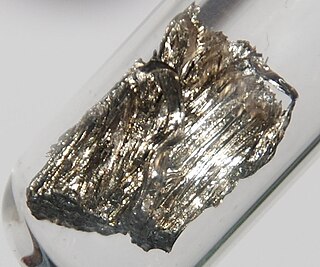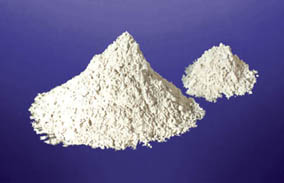
Boron nitride is a thermally and chemically resistant refractory compound of boron and nitrogen with the chemical formula BN. It exists in various crystalline forms that are isoelectronic to a similarly structured carbon lattice. The hexagonal form corresponding to graphite is the most stable and soft among BN polymorphs, and is therefore used as a lubricant and an additive to cosmetic products. The cubic variety analogous to diamond is called c-BN; it is softer than diamond, but its thermal and chemical stability is superior. The rare wurtzite BN modification is similar to lonsdaleite but slightly softer than the cubic form.

Samarium is a chemical element; it has symbol Sm and atomic number 62. It is a moderately hard silvery metal that slowly oxidizes in air. Being a typical member of the lanthanide series, samarium usually has the oxidation state +3. Compounds of samarium(II) are also known, most notably the monoxide SmO, monochalcogenides SmS, SmSe and SmTe, as well as samarium(II) iodide.

Samarium(II) iodide is an inorganic compound with the formula SmI2. When employed as a solution for organic synthesis, it is known as Kagan's reagent. SmI2 is a green solid and solutions are green as well. It is a strong one-electron reducing agent that is used in organic synthesis.

Aluminium nitride (AlN) is a solid nitride of aluminium. It has a high thermal conductivity of up to 321 W/(m·K) and is an electrical insulator. Its wurtzite phase (w-AlN) has a band gap of ~6 eV at room temperature and has a potential application in optoelectronics operating at deep ultraviolet frequencies.
In chemistry, a nitride is an inorganic compound of nitrogen. The "nitride" anion, N3- ion, is very elusive but compounds of nitride are numerous, although rarely naturally occurring. Some nitrides have a found applications, such as wear-resistant coatings (e.g., titanium nitride, TiN), hard ceramic materials (e.g., silicon nitride, Si3N4), and semiconductors (e.g., gallium nitride, GaN). The development of GaN-based light emitting diodes was recognized by the 2014 Nobel Prize in Physics. Metal nitrido complexes are also common.

Zinc nitride (Zn3N2) is an inorganic compound of zinc and nitrogen, usually obtained as (blue)grey crystals. It is a semiconductor. In pure form, it has the anti-bixbyite structure.
Samarium(III) sulfide (Sm2S3) is a chemical compound of the rare earth element samarium, and sulfur. In this compound samarium is in the +3 oxidation state, and sulfur is an anion in the −2 state.

Chromium nitride is a chemical compound of chromium and nitrogen with the formula CrN. It is very hard, and is extremely resistant to corrosion. It is an interstitial compound, with nitrogen atoms occupying the octahedral holes in the chromium lattice: as such, it is not strictly a chromium(III) compound nor does it contain nitride ions (N3−). Chromium forms a second interstitial nitride, dichromium nitride, Cr2N.
Samarium(II) fluoride is one of fluorides of samarium with a chemical formula SmF2. The compound crystalizes in the fluorite structure, and is significantly nonstoichiometric. Along with europium(II) fluoride and ytterbium(II) fluoride, it is one of three known rare earth difluorides, the rest are unstable.
The nitridogermanates are chemical compounds containing germanium atoms bound to nitrogen. The simplest anion is GeN48−, but these are often condensed, with the elimination of nitrogen.
Praseodymium(III) nitride is a binary inorganic compound of praseodymium and nitrogen. Its chemical formula is PrN. The compound forms black crystals, and reacts with water.
Samarium(III) phosphide is an inorganic compound of samarium and phosphorus with the chemical formula SmP.
Samarium(III) arsenide is a binary inorganic compound of samarium and arsenic with the chemical formula SmAs.
An iodide nitride is a mixed anion compound containing both iodide (I−) and nitride ions (N3−). Another name is metalloiodonitrides. They are a subclass of halide nitrides or pnictide halides. Some different kinds include ionic alkali or alkaline earth salts, small clusters where metal atoms surround a nitrogen atom, layered group 4 element 2-dimensional structures, and transition metal nitrido complexes counter-balanced with iodide ions. There is also a family with rare earth elements and nitrogen and sulfur in a cluster.

Europium compounds are compounds formed by the lanthanide metal europium (Eu). In these compounds, europium generally exhibits the +3 oxidation state, such as EuCl3, Eu(NO3)3 and Eu(CH3COO)3. Compounds with europium in the +2 oxidation state are also known. The +2 ion of europium is the most stable divalent ion of lanthanide metals in aqueous solution. Many europium compounds fluoresce under ultraviolet light due to the excitation of electrons to higher energy levels. Lipophilic europium complexes often feature acetylacetonate-like ligands, e.g., Eufod.
Samarium compounds are compounds formed by the lanthanide metal samarium (Sm). In these compounds, samarium generally exhibits the +3 oxidation state, such as SmCl3, Sm(NO3)3 and Sm(C2O4)3. Compounds with samarium in the +2 oxidation state are also known, for example SmI2.
Samarium(III) molybdate is an inorganic compound, with the chemical formula Sm2(MoO4)3. It is one of the compounds formed by the three elements samarium, molybdenum and oxygen.

Samarium(III) phosphate is an inorganic compound, with the chemical formula of SmPO4. It is one of the phosphates of samarium.
Samarium(III) perchlorate is an inorganic compound with the chemical formula Sm(ClO4)3.
Europium(III) nitride is a binary inorganic compound of europium and nitrogen with the chemical formula EuN.







